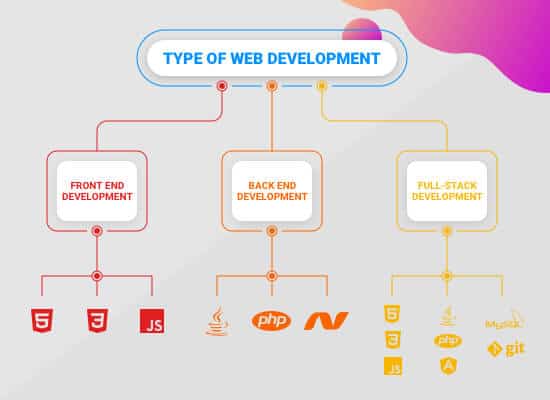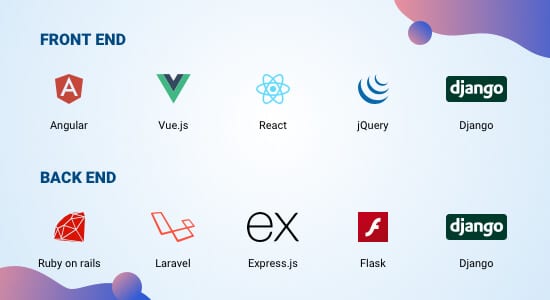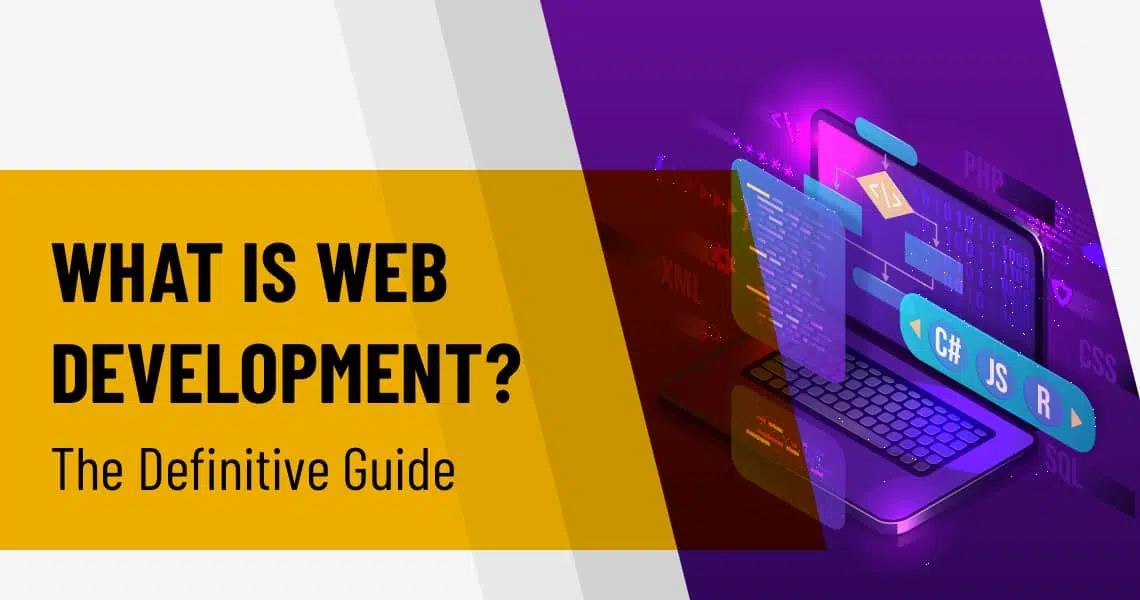An online presence is a must-have in today’s technology-driven world. Businesses looking to solve customer problems effectively can rely on web development.
Creating a website for business would help expand business reach and cater to wider audiences. Moreover, a business can leverage website development to create a strong online brand presence.
Also, blend in different web technologies to maintain a proper connecting channel between potential clients and the business. Simultaneously, a company’s popularity grows with a pervasive presence enabled by web development.
Currently, jobs in web design are on the rise. From 2019 to 2029, the employment of web developers and digital designers will expand by 8%, faster than the average for all other professions. The top 10% of the highest-paid Web Developers may make up to $108,000 annually.
With the aid of an IT firm, a business may tap into a whole new market to unlock profit through web apps. Before taking up a web development project, one needs to know about web development.
Table of contents:
What is Web Development? Why is Web Development Important?
Create Proprietorship
Publish Content
Control Over Brand Reputation
To Generate More Leads
1. Front-end Web Development
2. Back-end Web Development
3. Full-stack Web Development
Client-side Coding
Server-side Coding
Database Technology
1. Corporate
2. Ecommerce
3. Portfolio
4. TV or Video Streaming
5. Portals
Language Performance
The Deployment Time
Targeted Platform
Easier to Develop and Maintain
WordPress (WP)
Magento
Drupal
Custom CMS
Most Popular Web Development Tools:
Custom Website Development
Website Maintenance
Ecommerce Website Development
A. Planning
B. Create a Wireframe
C. Write Code and Back-end Support
D. Write Front-end Code
E. Use of CMS
F. Buy a Domain Name
G. Launch your Website
Web Development Courses
Web Development Communities
Web Development Blogs
Web Development Influencers to Follow
Web Development Resources
Code Repositories
Ready to Use Templates
Stack Overflow Jobs
What is Web Development?
Web development is creating websites and apps for the Internet or a private network known as an intranet. Web development isn’t about how a website looks; it’s about the coding and programming that operates it.
From the most basic, static web page development to social networking platforms and applications, from eCommerce websites to content management systems, developers created all of the tools we use daily via the Internet; at its core is web development.
Why is Web Development Important?
Web development is important for various reasons, including establishing an online presence for a company and developing a portal for people to buy items. The following are our top five points for the importance of web development;
Create Proprietorship
In today’s world, having a website and an online presence is critical for a brand and business. Users discuss a business on the internet through reviews and social media.
Some people may even use the term ‘directories.’ It is possible to handle customer feedback and respond appropriately by taking responsibility and building websites for the same.
Publish Content
Web development offers the space for individuals to post content online and convince people why they should collaborate with them or purchase from their brand. Content publishing platforms leverage WordPress and other CMS platforms for web development.
Control Over Brand Reputation
Any company’s brand reputation should be taken into account. The internet has replaced ‘word-of-mouth,’ establishing a strong brand identity and engagement driven by consumers through their friends and family. Positive reaffirmations of the business online drive more purchases over time.
To Generate More Leads
It is possible to create an online presence by establishing an online presence by using marketing resources such as Google Ads, search engine optimization, and social media advertising.
Businesses can target content to a specific set of users who fits into their targeted consumer segment and drive more leads over the website itself.
Hire dedicated team for your next web development project.
Three Types of Web Development
Comprehending the three basic forms of web development is necessary before understanding the web development process.
Let’s talk about the many categories and the technologies that go with them. This will help comprehend how each form of web development contributes to creating online solutions.

1. Front-end Web Development
Client-side web development refers to front-end web development which creates a website’s user interface using front-end technologies such as HTML, CSS, and JavaScript.
The goal of building the website’s front end is to make it easy for website users to read the content. Moreover, front-end developers/web designers must write efficient, clean code to provide an engaging User Interface (UI).
2. Back-end Web Development
Server-side web development is another term for back-end development where developers write codes and create the logical parts of a website. Back-end databases, servers, and APIs all will be part of this package.
The logical portion of a web project relies on the back-end, and one may not see the technology utilised to create a website. On the other hand, back-end web development is an essential component of every website.
3. Full-stack Web Development
The term full-stack web development refers to the development of both the front and back-end of a website. Web design, web programming, database management, and website debugging are all skills that a full-stack web developer should possess.
A full-stack developer is capable of creating both client and server-side web applications, as well as database administration.
Full-stack web developers are skilled at redesigning, building, and speeding up the whole design and development phase of a website. A web developer guide will help drive desired results when in the process of full-stack development.
Moreover, full-stack web engineers are responsible for researching web development processes such as blockchain, deep learning, and multi-cloud, depending on the projects.
Understanding the Web Development Hierarchy
Web development is the coding or website programming that enables a website to operate per the owner’s objectives. It mostly concentrates on the non-design elements of website development like markup authoring and coding.
Web page development covers the simple text pages to large web-based apps, social media applications, and e-commerce systems.
Following are the key aspects of the web development hierarchy.
Client-side Coding
This is coding for website development where the code is written in HTML, CSS, and JavaScript and is referred to as the front end. The entire code will be saved on the server, and the design will be pulled directly from the server whenever a user attempts to view the site.
Server-side Coding
The back-end of the structure is where programming languages such as Ruby, Python, and PHP are employed. The server-side also contains layers such as the display layer, application layer, and persistent storage layer.
Each layer is self-contained and functions independently of the others. As a result, modifications made to one component will not affect the others.
Database Technology
Of the many web development technologies, database technology holds greater importance as it is a collection of elements ranging from simple facts to sophisticated graphics that provide information about a certain subject.
A database is a collection of organised and structured data, and a database management system (DBMS) is a tool that maintains, organises, and interacts with databases.
Database management solutions come in a variety of shapes and sizes. Navigational DBMS, Relational DBMS, SQL DBMS, and Object-Oriented DBMS are the four main forms.
What are the Types of Websites and Web Applications?
1. Corporate
Corporate website and web application development can help multinational companies easily grow their business. It can help them to make the process smooth, reliable, and faster than ever before.
2. Ecommerce
One may name a web application an eCommerce web application if it advertises items or services directly to potential clients, similar to an online shopping store. Adding new items, removing obsolete and old products, monitoring payments, facilitating electronic payments, and a user-friendly interface are just some of the essential capabilities of the eCommerce web app. Professional website developers may make such programmes more user-friendly by customizing them.
3. Portfolio
In the realm of coding, this is a widely disputed topic. Many developers will proudly claim that they’ve never required one—they’ve gotten job offers after job offers based only on their resumes, active GitHub histories, and coding challenges.
A portfolio website development is essential for hiring potential employers and clients, whether you prefer front-end development or want to work as a freelance web developer.
While you’re more likely to hear about a portfolio about UX design, they’re also an excellent method to put yourself on the map as a web developer and lay out a stall.
4. TV or Video Streaming
In recent years, the market for video-on-demand and live streaming has exploded. This expansion is possible because of technological advancements like Artificial Intelligence (AI) for cinematography and video editing, as well as cloud-based video hosting options.
In addition, as digital media adoption rates rise across multiple business sectors, demand for high-quality streaming services and on-demand video content increases. The first step is to create a video streaming website.
Website development for the TV or video streaming will have users broadcast their video material and see the content provided by other site users. Producers and host programmes might potentially offer content to licence it. Everything is dependent on the company plan and how one wants to monetize the website.
5. Portals
A web portal is a secure, online, single point of access to structured data. It generally helps people sign in to gain access to their member accounts.
A web portal gathers information from several sources and organizes it in a single area where users may access it, showing data in other categories, connections, services, and interactive components.
Portals (such as eCommerce portals, customized web portals, etc.) frequently customize the information each user has access to base on their needs within the platform.
Hire on-demand dedicated developers of desired skill & experience.
Four Factors to Consider While Choosing a Web Development Platform
Language Performance
Using the language performance benchmark, you can determine how quickly a web development language will run.
The outcome may not be accurate, but it will give you an idea of whether or not to use a specific language. There are multiple types of web languages, and every developer will have a unique niche.
The Deployment Time
It is vital to consider the size of the code as the streamlined and less coded apps will take less time to deploy on a web server.
Targeted Platform
Web development should consider the platform the user might have, from Android, Linux, and Windows, to even Apple’s Mac or iOS. For instance, software that runs on Windows and Linux would need you to adopt Java.
Because when the Java Virtual System (JVM) is installed, your Java programme can execute on any machine.
Easier to Develop and Maintain
You should select a language that is simple to create and maintain. HTML, Python, Java, and PHP are more likely maintainable for a web development project. Web developers are also expected to be interested in learning these languages.
Web Development Platforms
There are multiple web development platforms that users can choose from. Here, we will discuss four main types of web development platforms that are widely adopted worldwide.
WordPress (WP)
WP is a PHP-based blogging platform that allows you to create your website on your server using a PHP/MySQL database. As one of the top web-building tools, this may be used to use web CMS services (Content Management System) for businesses.
Magento
Magento is a user-friendly, feature-rich eCommerce platform based on open-source technology that gives online merchants unparalleled freedom and control over their store’s design, content, and operation.
Magento is suitable for eCommerce businesses of any size — from those with just a few products to those with thousands.
Drupal
Drupal is a PHP-based open-source framework and native eCommerce solution. It’s also known as commerce 2, a Linux, Apache, MySQL, and PHP open-source stack, making Drupal both a CMS and a framework.
Custom CMS
The CMS, or content management system, is a simple platform that allows any authorised user to submit photos or information without needing to know PHP.
All major corporations extensively use CMS websites or blogs; it simplifies maintenance and grants permission to many users based on user roles to update items, photos, and material.
Most Popular Web Development Tools:
Some of the highly popular web development tools include
- Angular.JS
- Chrome DevTools
- Sass
- Grunt
- CodePen
- JQuery
- Bootstrap
- Visual Studio Code
- Sublime Text
- Sketch
- TypeScript
- GitHub
- NPM
Web Development Frameworks
Web application development has become substantially easier thanks to the advent of multiple frameworks based on various programming languages. It is one of the reasons for the rising demand for backend and frontend web developers. Here are some of the frontend and backend frameworks.
Developing web apps is simpler because of several frameworks based on different programming languages. That’s why backend and frontend developers are in great demand.
Here are some of the key web development frameworks to consider.

Developers may also use this framework to create a content management system (CMS) for managing digital material on the Internet. Developers may use the framework to develop content management capabilities, strong authentication features, and administration tools.
Types of Web Development Services
Custom Website Development
The field of web application includes programmes that run on several web servers and have a high level of user engagement, such as Google Apps, Facebook, or Netflix. Big corporations employ PHP, Ruby, Javascript, Python, and other types of web technologies for such web development services.
Website Maintenance
Website support and maintenance services include checking your website for errors regularly and ensuring everything is up to date and responsive. This must be done periodically to maintain the website current, safe, and dependable.
Ecommerce Website Development
Because of its convenience, online shopping is a popular choice among people. This pushes organizations to plunge into eCommerce web development and offer their items online.
Hiring web developers for the same ensures Magento development, WooCoomerce development, etc. Before you tie up with a developing firm, you must go through their web development service list to make a better decision.
Web Development Process
Creating web applications and their related services includes the following steps, which require successful execution.
A. Planning
Here, you’ll figure out what your website stands for and define the goal of creating one.
Answer questions regarding your target audience’s website style, research needs, promotional aspects, budgets, etc.
B. Create a Wireframe
Next, figure out the individual pages you want, how to organise them into categories, how the pages will connect, and how the user experience will be. Remember to make it as simple as possible for visitors to locate what they’re searching for.
C. Write Code and Back-end Support
This will be done by a back-end developer, who will use one of many coding languages to create the mainframe of your website. Most websites will have at least three coding languages that work together to provide the needed functionality.
D. Write Front-end Code
This is normally done by a front-end developer, who will take your website’s infrastructure and transform it into something aesthetically beautiful that visitors would love exploring. It includes images, fonts, colours, and basic styling.
E. Use of CMS
This step is optional, although it is frequently useful. You may skip most stages three and four using a content management system (CMS) like WordPress or Wix.
These solutions handle both front-end and back-end development in a straightforward and basic manner.
F. Buy a Domain Name
This is your website’s address, and it’s how visitors will find it. You’ll need to purchase a domain name and set up an address for visitors to access your website. For this, you can use the services of GoDaddy or Hover.
G. Launch your Website
This is the point at which your website goes live and may be viewed by everyone on the Internet. After completing some technical tests, you’re ready to share your website with the rest of the world.
Future Scope of Web Development
As we move closer to a more technologically advanced future, development talents are becoming increasingly in demand. Artificial intelligence (AI), machine learning (ML), the Internet of Things (IoT), quantum computing, and other technologies are transforming the IT industry. Even their relationship with the websites plays a role in this.
Therefore, it is best to leverage next-generation web development that uses and expands the web development scope for every business.
Learning Web Development
More website building materials can help you expand your expertise. You will find plenty of website development information online in various forms.
But here is some of the information that can help you.
Web Development Courses
When looking to get started with web design and development learning, below are some useful courses to enrol in.
Web Development Communities
Because web developers are masters of the Internet, they would only naturally congregate and network in online groups.
- Stack Overflow
- Mozilla Development Network
Web Development Blogs
These blogs provide a lot of website development information.
- https://careerfoundry.com/en/blog/
- https://www.smashingmagazine.com/
- https://alistapart.com/articles/
- https://www.digitalocean.com/community
Web Development Influencers to Follow
When looking for the right inspiration in the field, it is best to follow some of the popular web developers whose influence may prove helpful.
Web Development Resources
Code Repositories
- Bitbucket
- SourceForge
- GitLab
- AWS CodeCommit
Ready to Use Templates
Stack Overflow Jobs
Web Development Conferences
If you are looking to be a part of live, interactive web development conferences then you should definitely check these out.
- Deepsource.io
- Linuxfoundation
- Devopscon.io
- QCon sf
- Developersweek
FAQ about Web Development
PHP, Python, JavaScript, Ruby, Typescript
Recognise how visual design works.
Learn the fundamentals of HTML, as well as the fundamentals of CSS.
Familiarise yourself with the fundamentals of UI and UX design.
Create a basic website from the ground up and develop it as you gain knowledge of different web technologies.
Have a Web Development Project in Mind?
Now, whether you’re looking to create a reliable web-based or app solution, you can use some of the tips to choose a web development company having rich experience in providing top-notch services.




